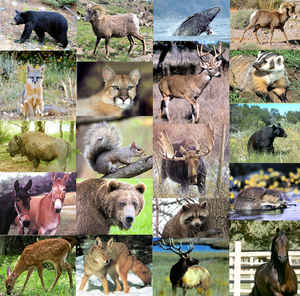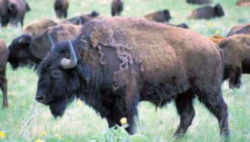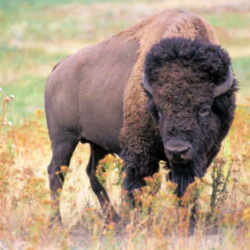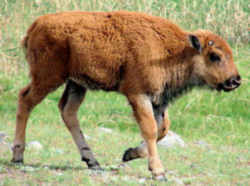What Is The State Animal Of Oklahoma

State Animals

Oklahoma Symbols

Oklahoma Symbols
Amphibian, Animate being, Anthem (Song), Balladeer, Beverage, Bird, Butterfly, Cartoon Character, Children Vocal, Colors, State & Western Song, Cowboy Poet Laureate, Crystal, Fish, Flag, Floral Emblem, Bloom, Flight Mammal, Folk Trip the light fantastic, Folk Song, Fossil, Fruit, Furbearing Creature, Game Beast, Game Bird, Gospel Vocal, Grass, Insect, Land Run Song, Meal, Motto, Musical instrument, Nicknames, Percussive Instrument, Pin, Poem, Poet Laureate, Quarter, Reptile, Stone, Rock Vocal (Erstwhile), Salute to the Flag, Seal, Soil, Tartan, Theatre, Tree, Vegetable, Waltz, Western Band, Wildflower
State Symbols Listing

- Land Resources
- » 50 States
- » State Symbols
- » Mammals
Oklahoma State Animal
American Buffalo, or Bison

(Bison bison)
Adopted in 1972.
The American Buffalo, or Bison, (Bison bison,) is a massive beast that weighs from 800 to 2,000 pounds and stands well-nigh six feet high at the shoulder. A large head, high hump on the shoulders and night dark-brown shaggy hair narrate the buffalo. Buffalo in one case roamed the American prairie past the tens of millions and provided a fashion of life for the plains Indians. But European settlers hunted buffalo to the brink of extinction - it's estimated that between 300 - 500 animals remained when the federal regime passed stricter game laws in 1889.
The bison was adopted as Oklahoma'due south state animal in 1972. Bison had been reintroduced to Oklahoma's Wichita Mountains National Wildlife Refuge in 1907. Rocky Mount elk were introduced from Jackson Hole, Wyoming, in 1911 to supersede the extinct eastern elk which once grazed alongside bison on the Bang-up Plains.
Did you know that: The bison has been proclaimed the official state animal or mammal in each of the following states
Land Symbol: Bison
Kansas | Oklahoma | Wyoming

Bison are part of the family unit Bovidae, to which cattle and goats belong. They are not in the same family that Asian and African buffalo are. However, because they resembled these old world animals, the early explorers called them by that name. Although information technology is a misnomer, the name buffalo is nevertheless used interchangeably with bison. 1 of the physical differences betwixt the erstwhile earth buffalo and the American bison is the big shoulder hump of the bison. This hump, forth with a broad, massive caput, short, thick cervix and small hindquarters give the creature its rugged appearance.
Characteristics of the American Buffalo, or Bison
The body of the bison is huge, ranging in length from 3.half-dozen m to iii.8 m in males to 2.13 m to 3.18 m in females. They are also tall animals, with the height at the shoulder ranging from one.67 one thousand to 1.86 k for males and 1.52 m to i.57 1000 in females. Two distinctive features of the bisons are the shoulder hump and their huge head. The color of the bison is brown, varying slightly from the front end and back of the animal. The pilus is longer in the front than in the rear of the bison. The distinction between hair length is more than noticeable in males than females. The horns of the bison are black, and they bend upward and in, ending in a sharp tip. The legs of the bison are brusk but firm. The hooves are black and are circular in shape (Meagher, 1986).
Food Habits
Bison are year round grazers. They feed primarly on grasses, just when food is deficient, they will eat vegetation such as sagebrush. On the boilerplate, bison ingest 1.vi% of their trunk mass per day of dry vegetation. Bison require water every day as well (Meagher, 1986).
Reproduction

Females are sexually mature in two to three years and males reach maturity around age three. Bulls, however, do not brood until six years of historic period. The breeding flavor begins in tardily June and lasts through September. Gestation is effectually 285 days, so the calving season is from mid-Apr through May. Whatever out of flavor births occur in the belatedly summer. Bison are born in an isolated location that has a lot of comprehend. Mothers protect the young from danger; males do non participate in this activity. One calf is born per season; the weight ranges from 15 kg to 25 kg. Male person calves are born a little more than ofttimes than females. The immature calves are red in color. They begin turning chocolate-brown in ii and a one-half months and are entirely brownish in four months. Calves are nursed for seven to viii months and are fully weaned by the stop of the first twelvemonth. Females are seasonally polyestrous with a bicycle of approximately three weeks. Oestrus may last anywhere from 9 to 28 hours (Meagher, 1986).
Beliefs
Bison are gregarious animals and are bundled in groups according to sex activity, age, flavor, and habitat. Cow groups are composed of females, males under 3 years of age, and a few older males. More males enter these groups as the rut approaches. Males live either individually or in groups that may exist as big every bit 30 head. Dominance betwixt the bulls is linear. Bulls that have a higher rank in the society breed more often than those of a lower rank. Cows too live in a linear dominance bureaucracy, which is established early on in life. Grazing takes place during several periods each day and is conducted in loose groups. When bison travel, they form a line. The traveling blueprint of bison is adamant past the terrain and habitat condition. An adult cow supplies the leadership. Bison are proficient swimmers equally well every bit runners, capable of reaching speeds of 62 km/hour.
The olfactory sense of bison is excellent and is essential in detecting danger. Bison can hear very well likewise. Bison are able to distinguish large objects from a distance of 1 km and moving objects ii km away. Bison can communicate vocally through grunts and snorts.
Copulation is initiated by the balderdash and is quick. During the rut, bulls fight among themselves. The corporeality of wallowing and tree horning likewise increases during the oestrus (Meagher, 1986).
Habitat
Originally, bison were found primarily in and at the fringes of open up prairie (Bart, 1957). Now, withal, because of their limited numbers, bison are establish in many fewer habitats and their movements are very controlled. Inside the national parks bison are plant at all elevations (Meagher, 1986).
Senate Concurrent Resolution No. 101
The American Buffalo, or Bison, was adopted by Senate Concurrent Resolution No. 101 on March 29, 1972.
ENROLLED SENATE
CONCURRENT
RESOLUTION NO. 101
A CONCURRENT RESOLUTION DESIGNATING AND ADOPTING THE AMERICAN BUFFALO OR BISON AS THE Land Animal OF OKLAHOMA; AND DESIGNATING DISTRIBUTION.
WHEREAS, the American Buffalo or Bison is widely and well known every bit the North American mammal of bang-up stature and great strength which the early explorers of our continent found in abundance on our Great Plains; and
WHEREAS, the American buffalo or Bison has come to be a symbol both of the backbone and perseverance that were necessary to "tame the West" and of man'southward responsibility to protect and preserve his natural environs; and
WHEREAS, the magnificent animal was native to both the grasslands and woodlands of what is now Oklahoma and was pregnant in the cultures and ceremonies of many of the Indian tribes who lived in Oklahoma and have passed along their heritage to modern day Oklahomans; and
WHEREAS, the American Buffalo or Bison now is preserved and protected in the Wichita Mountains Wildlife Refuge and in other public and individual areas of the State where continuing efforts are done to develop the husbandry of this greatest of the native grazing bovines.
Now, THEREFORE, BE Information technology RESOLVED Past THE SENATE OF THE second SESSION OF THE 33RD OKLAHOMA LEGISLATURE, THE HOUSE OF REPRESENTATIVES CONCURRING THEREIN:
Section 1. The American Buffalo or Bison is hereby designated and adopted every bit the State Brute of the Country of Oklahoma.
SECTION 2. Copies of this Resolution shall be distributed to the historical societies, museums and public and school libraries of the Country of Oklahoma.
Adopted by the Senate the 16th day of March, 1972.
Adopted past the Business firm of Representatives the 29th day of March, 1972.
Oklahoma Police force
The Oklahoma State Legislature named the bison Oklahoma's official state fauna by concurrent resolution and it is, therefore, not listed in the Oklahoma Statutes.
Taxonomic Hierarchy: American buffalo.
Kingdom: Animalia
Phylum: Chordata
Form: Mammalia
Superorder: Ungulata
Order: Artiodactyla
Family: Bovidae
Subfamily: Bovinae
Genus: Bison
Species: B. bison - (Linnaeus, 1758)
Subspecies: B. b. athabascae
Subspecies: B. b. bison
Synonyms: Bos americanus; Bos bison; Bison americanus; Bison bison montanae
State Mammals

Mammals are vertebrates (backboned animals) that feed their immature on female parent'due south milk.
Source: https://www.ereferencedesk.com/resources/state-mammal/oklahoma.html
Posted by: feltthook1983.blogspot.com

0 Response to "What Is The State Animal Of Oklahoma"
Post a Comment